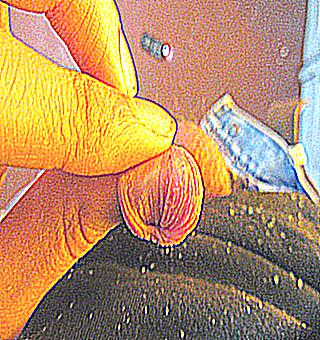Home >
Erectile Dysfunction >
Phimosis
Phimosis

Phimosis is a condition of the penis in which it is impossible to fully open the head of the penis. This is recognized as a physiological norm for boys up to the age of three, but at an older age, the foreskin should shift and release the entire head. Narrowing of the prepuce can cause soreness, infection, and urinary problems.
Reasons
There are several factors that can increase the risk of developing phimosis. These include:
- Inflammatory process resulting from neglect of hygiene rules or damage to the foreskin due to injury
- The result of balanoposthitis (inflammation localized on the head of the penis and foreskin)
- Insufficient elasticity of the connective tissue caused by a hereditary predisposition
- Synechiae preventing the displacement of the foreskin (normal up to 3 years)
- Temporary or permanent discrepancy between the diameter of the outer opening of the prepuce and the head of the penis as a result of active growth (in childhood)
Physiological phimosis passes without surgery and, in the absence of infection, is not dangerous to the patient's health. The pathological form of this disease is curable only by an operable way.
Signs and stages of phimosis
The disease has very characteristic features and cannot be mistaken for another disease. In addition to the impossibility of completely exposing the head of the penis, the following symptoms of phimosis are determined:
- problems with urination
- pain with erection
- blue discoloration and swelling of the glans penis (with paraphimosis)
- hyperthermia (increased body temperature) with accompanied by phimosis with a bacterial infection
- purulent discharge accumulating in the preputial sac (the area between the foreskin and the head of the penis)
The symptomatology of the disease depends on the degree of development of the disease. In medicine, there are 4 stages of pathology:
- 1st degree - the problem of freeing the head of the penis appears only with an erection
- 2nd degree - it is difficult to bare the head of the penis in a calm state, but possible. With an erection, manipulation is impossible
- 3rd degree - it is impossible to bare the head of the penis in a relaxed state
- 4th degree - in addition to the signs of the 3rd stage, there are difficulties with urination
The consequences of the disease depend on the degree of neglect of the pathology and the treatment undertaken. Possible complications:
- Paraphimosis - infringement of the head by the tissue of the foreskin, occurs with a disease of 2-3 degrees as a result of sexual intercourse or hygiene procedures. It is fraught with tissue necrosis, so it is important to see a doctor immediately
- Fusion of the foreskin with the head of the penis. At the 3rd and 4th stages of the disease, there is a risk of loss of elasticity of the synechiae (adhesions) connecting the head and the inner side of the prepuce
- Smegmolytes. At 3-4 degrees of phimosis, it is quite difficult to carry out hygienic procedures efficiently. Therefore, accumulation of smegma is often observed (connection of the secretion of the sebaceous glands, fluid, dead epithelial cells). When this substance stagnates, it hardens, smegmolytes are formed
- Infections. Hygiene problems resulting from phimosis create a favorable environment for the development of pathogens. The most common pathologies associated with tissue infection are balanitis and balanpostitis
If discomfort occurs, experts recommend seeking medical help at any stage of pathology development.
Diagnostics and treatment
Additional diagnostic methods, except for the collection of anamnesis and examination, are not required. Therapy depends on the stage of the disease, complications and symptoms. Experts are divided in opinions at what age the physiological form of the disease can be attributed to congenital pathologies. Approximate age - up to 7 years, the foreskin should freely release the head of the penis and not provoke pain, not create problems with hygiene. For older boys, the doctor may advise an operable solution to the problem. Congenital phimosis is operated by separating the adhesions of the preputial sac. Sometimes it is enough to use a probe and surgical intervention can be avoided. Circumcision (or circumcision) is the most effective way to solve the problem with the only contraindication - balanoposthitis.
Preventive measures
Phimosis is a pathology with a genetic predisposition. To avoid the onset and development of the disease, you need to explain to the child the importance of high-quality hygiene procedures as soon as possible. Washing with soap and timely removal of smegma from the preputial bag is the main method of prevention. Phimosis rarely leads to complications - for this you need to ignore the discomfort for a long time. Careful attention to your health and personal hygiene will help you avoid unpleasant symptoms and surgical procedures.



























